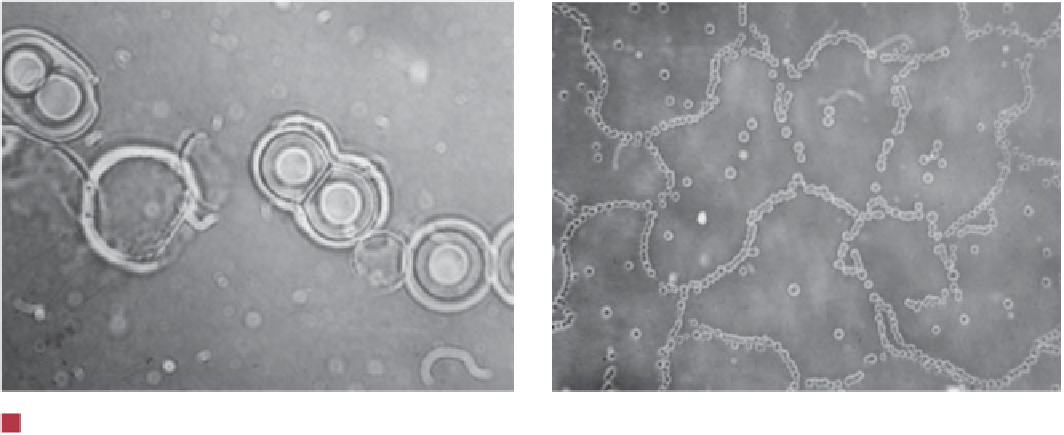Geology Reference
In-Depth Information
that have a cell-like outer covering and grow and divide
somewhat like bacteria do (Figure 19.18b).
Perhaps the fi rst steps leading to life took place as mono-
mers formed in great abundance and polymerized, but little
is known about how a reproductive mechanism came about.
Microspheres divide but do so in a nonbiologic manner.
In fact, for some time, researchers were baffled because in
present-day organisms either DNA or RNA is necessary for
reproduction, but these nucleic acids cannot replicate with-
out protein enzymes, yet protein enzymes cannot be made
without nucleic acids. Or so it seemed until a few years ago,
when researchers discovered that some small RNA molecules
can in fact reproduce without the aid of protein enzymes.
So, the first replicating system might have been an RNA
molecule. Just how these molecules were synthesized under
conditions that existed on early Earth has not been resolved.
A common theme is that life originated when organic mol-
ecules were synthesized from atmospheric gases, but this idea
has been challenged by those who think that the same sequence
of events took place near hydrothermal vents (black smokers)
on the seafl oor (see Figure 9.12c). The necessary elements (car-
bon, hydrogen, nitrogen, and oxygen) are present in seawater,
and heat may have been the energy necessary for monomers to
form; in fact, amino acids have been detected in some of these
vent waters. Those endorsing this view hold that polymerization
took place on the surfaces of clay minerals, and fi nally protocells
were deposited on the seafl oor.
atmosphere, composed of carbon dioxide (CO
2
), water va-
por (H
2
O), nitrogen (N
2
), and probably ammonia (NH
3
)
and methane (CH
4
), provided carbon, oxygen, hydrogen,
and nitrogen, the primary elements that make up all organ-
isms. Lightning and ultraviolet radiation were two possible
sources of the energy necessary for these elements to com-
bine and form rather simple organic molecules known as
monomers
,
such as amino acids.
Monomers are needed as basic building blocks of more
complex organic molecules, but is it plausible that they
formed naturally? Experimental evidence indicates that it is.
During the 1950s, Stanley Miller circulated gases approxi-
mating Earth's early atmosphere through a closed glass ves-
sel and subjected the mixture to an electric spark to simulate
lightning. Within a few days, the mixture became turbid and
an analysis showed that Miller had synthesized several amino
acids common in organisms. More recent experiments using
different gases have successfully synthesized all 20 amino ac-
ids in organisms.
Making monomers in a test tube is one thing, but
organisms are composed of more complex molecules called
polymers
, such as nucleic acids (DNA and RNA) and pro-
teins consisting of monomers linked together in a spe-
cific sequence. So how did this linking of monomers, or
polymerization, take place? Researchers have successfully
synthesized small molecules called
proteinoids,
consisting of
more than 200 linked amino acids (
Figure 19.18). In fact,
when heated, dehydrated, and concentrated, amino acids
spontaneously polymerize and form proteinoids.
We call these artifi cially synthesized proteinoids
protobi-
onts,
meaning they have characteristics between those of in-
organic chemical compounds and living organisms. Suppose
that these protobionts came into existence as outlined above.
They would have been diluted and would have ceased to ex-
ist if they had not developed some kind of outer covering. In
other words, they had to be self-contained chemical systems
as today's cells are. In the experiments just mentioned, pro-
teinoids have spontaneously aggregated into microspheres
◗
Prior to the mid-1950s, scientists assumed that the fossils so
abundant in Cambrian rocks had a long earlier history, but
they had little direct knowledge of Precambrian life. During
the early 1900s, Charles Walcott described layered mound-
like structures from the Paleoproterozoic-age Gunfl int Iron
Formation of Canada that he proposed were constructed by
algae. We now call these structures
stromatolites
, but not
until 1954 did scientists demonstrate that they are actually
◗
Figure 19.18
Proteinoids and Microspheres
a
Bacteria-like proteinoid.
b
Proteinoid microspheres.


Search WWH ::

Custom Search